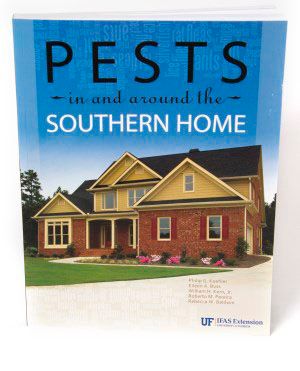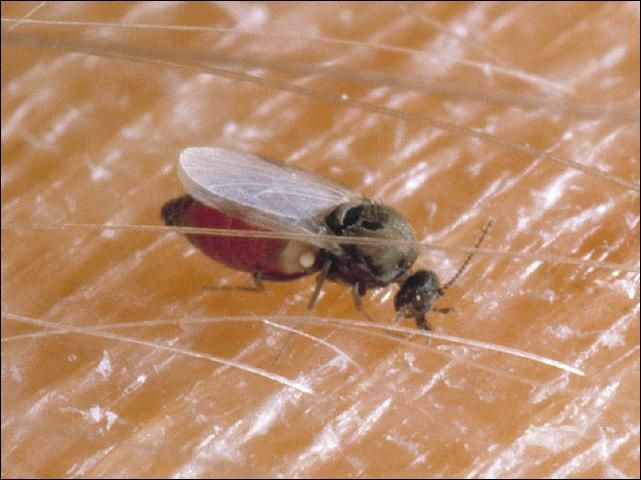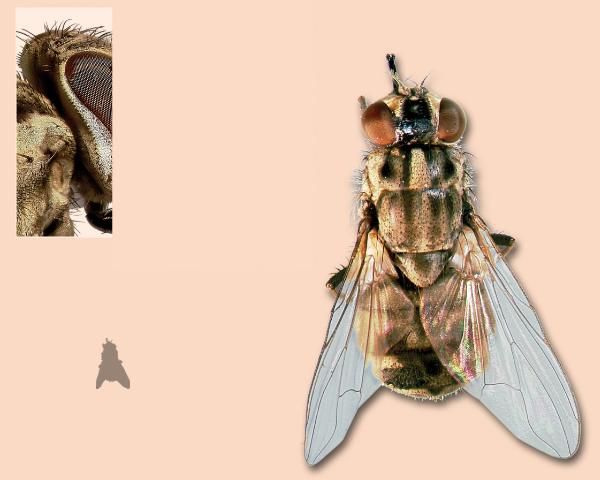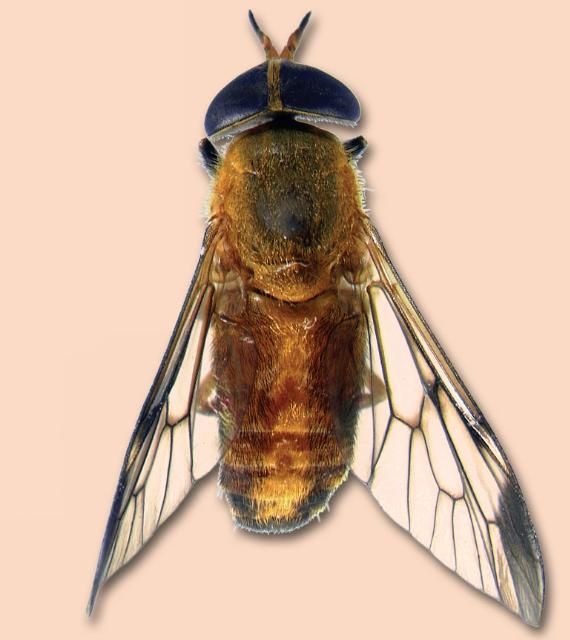
Credits: UF/IFAS
Many biting flies persistently attack man and animals to obtain a blood meal. The feeding activity of these insects is often very annoying and can result in injury or disease transmission. Biting flies of medical and veterinary importance include no-see'ums, black flies, stable flies, mosquitoes (see ENY-2004), horse flies, and deer flies.
No-see'ums
No-see'ums are members of the insect order Diptera that undergo complete metamorphosis including the egg, larva, pupa, and adult forms. The adults are less than 1/16 inch (1.6 mm) long, dark gray to black, and have one pair of spotted wings. Although no-see'ums breed predominantly in salt marshes, some inland species breed in tree holes and other fresh water areas.
The larvae of this pest are often found in mud, sand, and other moist debris surrounding the edges of ponds, springs, lakes, creeks, tree holes, or on slime-covered bark. In the water, larvae occur as free-living swimmers that are commonly found on floating twigs or leaf debris. In Florida, larvae can be found in marshes year-round with the period of greatest adult activity during June, July, and August. Eventually, the larvae enter the pupa stage on floating debris or at the water's edge where they remain until emerging as adults. Like mosquitoes, adult female no-see'ums require blood to develop their eggs; males do not bite.
Adult no-see'um activity is associated with air movement. Subsequently, little feeding occurs in the presence of a slight breeze. No-see'ums are also sensitive to temperature. Animals with a high body temperature are most attractive to great numbers of female no-see'ums. In addition, persons performing hard labor outdoors are frequently severely annoyed by these insects.

Black Flies
Black flies (Simuliidae) (Figure 2) are small, dark, stout-bodied insects with a hump-backed appearance. Adult females are not host specific and feed on blood primarily during daylight hours. It hovers about the eyes, ears, and nostrils of man and animals, often alighting and puncturing the skin causing severe irritation. However, black flies are not considered major pests of homeowners in Florida.

The black fly life cycle begins when eggs are deposited on logs, rocks, or solid surfaces in swiftly flowing, oxygenated streams. Larvae attach themselves to underwater rocks or vegetation with a posterior sucker. The length of the larval period varies depending on the species and conditions within the larval environment. Adult black flies emerge after pupation and begin searching for new hosts. These pests are strong fliers and are known to travel 7 to 10 miles (11 to 16 km) from their breeding sites.
Stable Fly
The stable fly (Figure 3), also known as the dog fly, is a blood-sucking pest that closely resembles the house fly. It is similar to the house fly in size and color, but is easily recognized by its large, piercing mouthparts, which project forward from the head. Unlike many blood-feeding insects, such as mosquitoes, both sexes of the stable fly feed on blood.

The stable fly is a common pest of man and animals throughout the world. Stable flies are strong fliers that can travel up to two miles in search of a blood meal. Because they are persistent and easily interrupted during feeding, they often attack more than one host, increasing the potential for disease transmission. Although stable flies may be mechanical vectors of several animal diseases, they are not known to play a significant role in spreading human pathogens.
In Florida, cattle persistently attacked by stable flies feed less efficiently, resulting in reduced weight gain and milk production. In addition, losses to the Florida tourism industry have occurred when large stable fly populations appear on the Gulf Coast, driving away beach-goers.
After acquiring several blood meals over the course of three to five days, females will mate and develop a batch of eggs. At this time, the female stable fly will seek out areas such as soiled animal bedding, spilled animal feeds, compost piles, and even seaweed deposits along beaches to deposit her eggs. Once an area is located, the female will crawl into the loose material, laying eggs sporadically as she moves. Each female will live for 20 to 30 days as an adult, laying between 500 to 600 eggs during her lifetime. The eggs hatch in 24 to 48 hours, and the larvae develop for a period of 14 to 26 days. The average stable fly life cycle is 28 days and can vary from 22 to 58 days, depending on weather conditions.
Horse Flies and Deer Flies
Horse flies (Figure 4) and deer flies (Figure 5) are closely related insects with similar life cycles. Both pests are strong fliers and only the adult female bites. They are daytime feeders that use large piercing mouthparts to lacerate host skin for a blood meal. While feeding, an anticoagulant is injected into the wound, increasing blood flow. These wounds can often serve as sites for secondary infections and many people are allergic to the feeding activities of these pests. In addition, horse flies and deer flies are important agents of disease transmission due to their intermittent feeding activity.


Most species of horse flies and deer flies have aquatic or semi-aquatic immature stages. Some will also develop in moist soil, leaf debris, or rotting logs. The eggs are generally deposited in layers of vegetation, objects over water, or other moist areas favorable to larval development. Five to seven days after hatching, the larvae travel to the water surface or other moist areas and begin to feed on organic matter.
The larvae of many species also feed on insects, crustaceans, snails, earthworms, and even small vertebrates such as tadpoles and minnows. When the larvae are ready to pupate, they move to drier areas, usually an inch or two below the soil surface. The pupal stage usually lasts two to three weeks, concluding with adult emergence. The life cycle of horse flies and deer flies varies considerably depending on species, requiring anywhere from 70 days to two years.
Control of Biting Flies
Many biting flies including no-see'ums, black flies, horse flies, and deer flies breed in water or in mucky areas near ponds and swamps. Consequently, it is difficult to attempt control measures for these pests through reduction of breeding sites. Contact your local mosquito control district for information concerning management programs in your area to control biting flies.
Stable flies breed in decaying grass or crop clippings, hay residues, and silage. Because they are extremely strong fliers, the source of a stable fly infestation may originate well over one hundred miles away. However, localized control measures can be effective and include trapping, pesticide use, and removal of larval breeding sites.
Many biting flies are active at certain times during the day and particular months during the year. Horse flies, deer flies, black flies, and stable flies are usually most active during the day. No-see'ums are usually most active around sunrise and sunset. In Florida, stable flies are most abundant during the late fall, with populations peaking in early January. Deer flies and black flies are most prevalent in early to late spring. No-see'ums are most abundant during summer months but may bite at any time during the year.
If it is necessary to go outdoors into areas where biting flies are prevalent, it is important to wear protective clothing. Long-sleeved shirts and long pants will protect arms and legs from the feeding activity of biting flies. If necessary, application of a repellent labeled for biting fly protection may be appropriate. It is always important to apply products according to label directions and to reapply only as needed. Most repellents do not work as well for biting flies as they do for mosquitoes, and therefore must be reapplied more often.
Biting flies are most active in still air areas. Increasing air movement in porches, patios, and picnic areas will keep biting flies away but may not provide complete protection. Burning repellent candles, coils, and torches containing citronella or other biting fly deterrents will sometimes help reduce biting fly activity. Because most biting flies often rest in vegetation, pruning shrubs and mowing weedy areas may promote localized environmental air flow reducing numbers of biting flies entering the area.
Despite all efforts, biting flies may still be a problem. If biting flies enter a dwelling, they can be treated with space sprays to kill them. Before application of a space spray, it is important to remove all people and pets from the dwelling, turn off air handling systems, and keep the room vacant as long as directed by the manufacturer.
Crack-and-crevice treatments can be used to treat areas around doors and windows where biting flies can enter the house.
Biting flies usually rest on vegetation or on the sides of houses before biting or following people into a dwelling. Numbers of biting flies around houses can be reduced by applying outdoor barrier treatments to these areas. It is also important to use any barrier treatment as directed by the manufacturer.